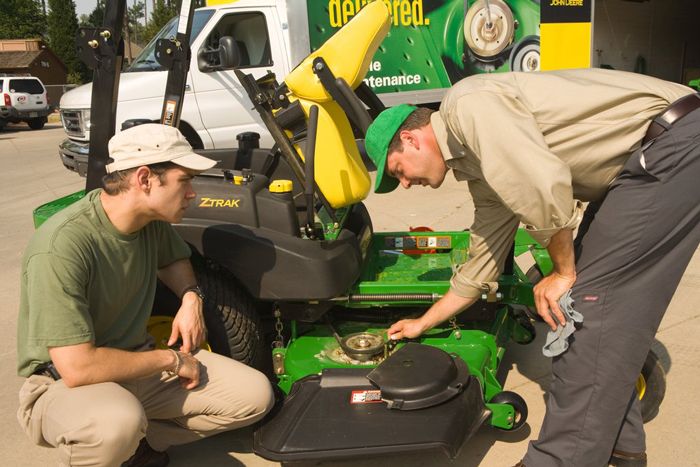Interested in printing this article out and sharing it with your staff? Click the button below for a printer-friendly version:
Printer-Friendly Version
Editor’s Note: Read Part 1, Increasing Your Billable Time, to learn about the first steps to setting up an efficient, profitable service department.
In Part 1, we talked about the first steps in terms in checking in equipment for service. The next step in your process is to make sure that every night before you leave, your shop is loaded and ready for work the next day. Once a tech walks into the shop, they should clock onto a work order and begin making both the dealership and themselves money.
This doesn’t happen by accident. In fact, if you don’t do this every morning, you are barraged by both techs and customers trying to get your attention, and the forest fire begins. A service manager’s job is so much easier if the shop is set before they go home. Then, the techs come in each morning knowing what they have to do and have the parts they need to do the work. Most of the service departments we consult with add an additional person to the service department called a service coordinator who helps with the triaging, cleaning and movement of equipment and parts into and out of the shop. (For more on the service coordinator, read “Service Coordinators Enhance the Flow of Your Service Department.” This service coordinator becomes your support person in the shop whose last job of the night is to get the shop set, with your direction, for the next day.
With all the parts pulled, or at least all the parts we think we will need pulled, and the equipment cleaned and lined up based upon the flow you decided last night, your techs are ready to turn your shop into a cash machine. All you have to do now is feed the beast that you have created.
The service coordinator is working to keep the shop clean as the techs do their work. The techs are taking the parts out of the tubs you have lined up for them and installing them on the equipment. Each work order includes the time they need to meet or beat to get a bonus, and things begin to flow smoothly. There will be glitches along the way but, in my experience, 80% of the work you have planned to accomplish will be done on or before the time you allocated for the work.
Create a High Performance Dealership with Bob Clements is a new series brought to you by Yanmar.
Yanmar — Don’t settle for less when you can have more. For example, Yanmar makes all its compact tractors’ major drivetrain components – the Yanmar engine, transmission, and axles — in-house. Because they’re made to work perfectly together, you and your customers get a hardworking machine with more usable horsepower, less power loss, and a smoother, more comfortable ride. Yanmar’s tractors are designed to work as hard as you do for a lifetime. Strengthen your dealership with Yanmar today: AgMarketing@yanmar.com or call 770-877-9894.
When issues happen, you make some adjustment of work flow and move the last part of that day’s work to the following day. I encourage the dealers to build a minimum of 2 hours of emergency time per tech into each day to help with any bumps in the road. If you need the time, it is available, and if you don’t need it, you will know by early afternoon and can work with the service coordinator to move the first part of tomorrow’s work into today’s schedule. Either way you do it, it’s a win for both your service department and your customers.
Moving Through the System
If all has gone well with the service or repair, the service tech will complete all the information on the work order, documenting what they have done and the time it has taken them to complete the repair. At this point in your process, the tech will take the blue ribbon off the equipment and replace it with a green ribbon. The green ribbon in your system denotes that the equipment has been serviced or repaired based upon the customer request and meets the quality standard of your service department.
I put a very high value on a tech putting the seal of approval on the work that they do. That green ribbon is that tech’s quality assurance stamp. If we are going to have a service department that is both profitable for us and an excellent experience for our customers, the equipment that goes through our shop has to be repaired correctly so we don’t get a call from the customer after they get it home informing us that the problem or issue still exists.
In shops, I am constantly stressing the importance of professionalism. Amateurs have comebacks and “redos.” Professional technicians take pride in their work and make sure it’s right before the customer gets their equipment back. Commitment to quality work is a part of our service standard and happens with good processes.
There are times in the service process that we run into an unforeseen problem and need an additional part that we don’t have in stock or find that we have a part, but need to get additional customer approval to do the work. At this point in your process, you should introduce a yellow ribbon. The yellow ribbon lets you know that work was halted by the tech on a piece of equipment and the equipment is going to be removed from the day’s service process until the parts arrive or the customer issues additional approval. Once either of those two situations happens, the equipment fills one of the emergency slots you set up in your process and reenters the shop for completion and that coveted green ribbon.
At this point in your process, you are ready to contact the customer to let them know their equipment is finished and ready to be picked up or delivered. If the customer picks up the equipment, the service coordinator retrieves it from the storage area where all the other equipment with green ribbons is located and takes it to the customer. Prior to the customer getting the equipment back, it should be started and operated in front of the customer so they know it meets their expectations.
It’s important to keep in mind that parts and service add great opportunities to enhancing the dealership’s bottom line. Regardless of where the product came from, we want to service and sell parts to the customer so that we have the opportunity to sell them their next piece of equipment. Customers that have a chance to experience your service process are going to be delighted with the results and will come back and tell others to bring their equipment to you for service. Having a strong process in place for your service department becomes a game changer and is guaranteed to make your life simpler and your shop more profitable.
Create a High Performance Dealership with Bob Clements is a new series brought to you by Yanmar.
Yanmar — Don’t settle for less when you can have more. For example, Yanmar makes all its compact tractors’ major drivetrain components – the Yanmar engine, transmission, and axles — in-house. Because they’re made to work perfectly together, you and your customers get a hardworking machine with more usable horsepower, less power loss, and a smoother, more comfortable ride. Yanmar’s tractors are designed to work as hard as you do for a lifetime. Strengthen your dealership with Yanmar today: AgMarketing@yanmar.com or call 770-877-9894.







Post a comment
Report Abusive Comment